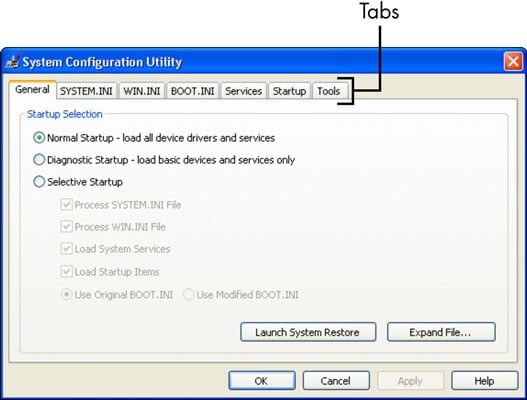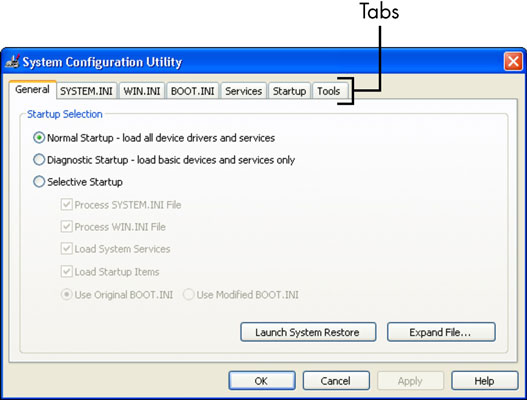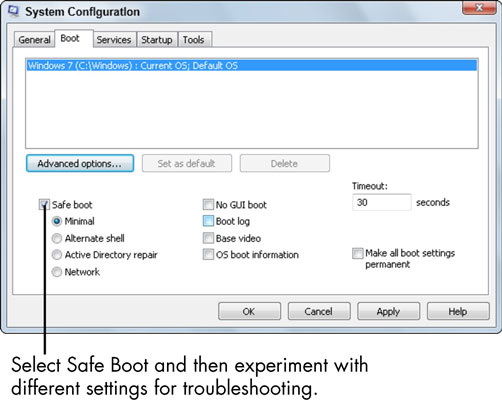How To Know Computer Configuration In Windows 7
View system configuration in Windows XP
Hither's how to have a look at your system's settings.-
Choose Start→Run to open up the Run dialog box. Type msconfig in the Open text box and click OK.
The Organization Configuration Utility dialog box appears, displaying seven tabs. Each tab contains settings for various elements of your PC.

-
Click the Services tab.
Yous meet a long list of the current software services running in Windows.
-
Click the Startup tab.
This tab lists the programs that launch every time you start your machine.
-
Click the Tools tab.
Information technology lists the software tools you can utilize to inspect or troubleshoot your arrangement. (Interestingly, Microsoft's help-desk-bound technicians may use the same tools to help you uncover and repair a problem with your estimator.)
-
When you're gear up to become on with other computer tasks, click the OK push button.
The System Configuration Utility dialog box closes.
Select diagnostic startup in Windows XP
It certainly is interesting to poke around inside the Arrangement Configuration Utility, but y'all also can employ it equally a serious diagnostic tool.
-
Choose Start→Run to open the Run dialog box, blazon msconfig in the Open text box, and click OK.
The System Configuration Utility dialog box appears.

-
On the General tab, select Diagnostic Startup and click OK.
The utility takes a few seconds to disable all but the most essential startup programs and services.
-
When the Restart/Leave prompt appears, click Restart. When the diagnostics notification appears, click OK.
Windows displays the Arrangement Configuration Utility dialog box again.
-
Click the Startup tab, scan the list for a program that's a likely troublemaker, and check its check box.
You recognize a troublemaker through a procedure of elimination and good guessing. Analyze the problem that y'all're experiencing and try to find an awarding that may have something to do with information technology. Start with annihilation that isn't a Microsoft product and, therefore, may be incompatible with Windows.
-
Click OK to restart your estimator in Selective Startup mode. If the problem recurs, go on to the side by side step. If the problem doesn't occur, repeat the steps until y'all locate the offending awarding.
Reinstall the problem program or contact the software manufacturer for assist.
-
Render your system to normal startup. To do so, choose Beginning→Run to open up the Run dialog box. Blazon msconfig in the Open text box and click OK.
The System Configuration Utility dialog box opens.
-
On the Full general tab, select Normal Startup and click OK.
Your computer restarts with all its programs enabled.
View system configuration in Vista and Windows 7
Viewing the system configuration in Vista and Windows 7 is different than in Windows XP:
-
Click the Outset push button and then click inside the Search Programs and Files field (Start Search in Vista) at the bottom of the screen.
The msconfig program appears at the peak of the search box.
-
Click msconfig to brandish the System Configuration dialog box.
Vista displays a UserAccount Control find.
-
Investigate the Services, Startup, and Tools tabs.
These tabs are essentially the same as those in the Organisation Configuration Utility dialog box in Windows XP. Missing from the System Configuration dialog box, nonetheless, are the .INI tabs from Windows XP — which is probably a skillful thing, because you shouldn't alter those settings anyhow.
-
Click the Kicking tab.
The System Configuration dialog box appears.

-
Click the General tab, cull Diagnostic Startup, and click OK to test your system with minimal applications loaded. When finished, select Normal Startup on the Full general tab and click OK.
Yous render to normal startup mode, and your computer restarts with all its applications enabled.
About This Commodity
This commodity can be found in the category:
- Basic Skills ,
Source: https://www.dummies.com/article/technology/computers/basic-skills/for-seniors-how-to-check-and-change-your-computer-systems-configuration-191688/
Posted by: hayesancour.blogspot.com

0 Response to "How To Know Computer Configuration In Windows 7"
Post a Comment